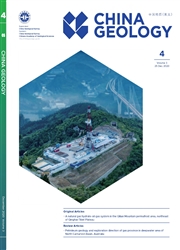Palynology and stratigraphy of the thick evaporate-bearing Shashi Formation in Jiangling Depression,Jianghan Basin of South China,and its paleoclimate change
作者:Chun-lian Wang,Cheng-lin Liu,Jiu-yi Wang,Xiao-can Yu,Kai Yan
摘要:In the greater inland Jianghan Basin of South China,three salt depressions are lacking accurate geological times,of which Jiangling Depression is the largest.Evaporites are important records of paleoclimate,however,the geological ages of evaporates are very difficult to be determined because often evaporates have scare macrofossils and microfossils.Nonmarine Cretaceous to Tertiary halite deposits interbedded with mudstones are widely distributed in China.Paleocene-Eocene Thermal Maximum had very high temperatures and attracted strong interests of geologists because these times can be compared with future climate change because of global warming.However,previous studies focused on marine sediments found that during the Paleocene-Early Eocene,massive evaporate deposits formed in Jiangling depression of the Jianghan Basin.In this paper,the authors show that the Shashi Formation halite deposits formed in the Paleocene according to palynology.Most of these palynology fossils are arid types,so the massive evaporites in the Jiangling depression could be closely related to the hot Paleocene climate.High temperatures during the Paleocene contributed to the formation of the massive evaporates in the Jiangling Depression,until sylvite was the result.
发文机构:Ministry of Natural Resources Key Laboratory of Metallogeny and Mineral Assessment
关键词:PALYNOLOGYGeologicalageofevaporateSYLVITEPaleocenePALEOCLIMATEShashiFormationMineralexplorationengineeringSouthChina
分类号: P53[天文地球—古生物学与地层学]
- Discovery of shale gas from Wufeng-Longmaxi Formation in Xianfeng area, Hubei Province, China
- Deep gold mineralization features of Jiaojia metallogenic belt,Jiaodong gold Province:Based on the breakthrough of 3000 m exploration drilling
- Baddeleyite and zircon U-Pb ages of the ultramafic rocks in Chigu Tso area,Southeastern Tibet and their constraints on the timing of Comei Large Igneous Province
- Genesis of green sandstone/mudstone from Middle Jurassic Zhiluo Formation in the Dongsheng Uranium Orefield, Ordos Basin and its enlightenment for uranium mineralization
- Effects of heavy metal pollution on farmland soils and crops:A case study of the Xiaoqinling Gold Belt,China
- The second natural gas hydrate production test in the South China Sea
- Origin of the Oligocene Tuolangla porphyry-skarn Cu-W-Mo deposit in Lhasa terrane,southern Tibet
- Protoconodont fossils for refining the Cambrian bottom and the contribution to shale gas formation along the southwest margin of Yangtze Block
- The introduction of traditional Chinese mineral medicine
- Characteristics of tectonic deformation of the melange zone in the Lachlan Orogen along eastern coast of Australia


